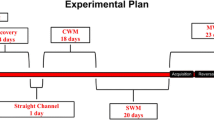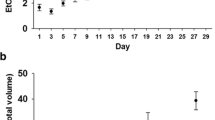Abstract
To date, joint use of alcohol (EtOH) and methamphetamine (MA) represents a specific combination of polydrug abuse. Repeated administrations of EtOH, MA, and combined EtOH and MA were assessed for their effects on brain cell toxicity, cell mitosis and anxiety/depression-like behavior. We found that repeated co-administrations of EtOH and MA produced profound anxiogenic effects. Specifically, combined EtOH and MA decreased open arm exploratory responses in the elevated plus maze test. Moreover, combined EtOH and MA significantly decreased immobile responses in the tail suspension test. MA, EtOH, and their combination all reduced the number of NeuN-positive cells in amygdala (Amg), while neither of them altered the number of NeuN-positive cells in striatum (St) or prefrontal cortex (PFC). Combined EtOH and MA decreased the number of NeuN-positive cells in dentate gyrus (DG). EtOH, MA, and combined EtOH and MA all diminished comparable number of GFAP-positive cells in Amg, DG, and St. Neither of these treatment affected the number of GFAP-positive cells in PFC. EtOH, MA, and combined EtOH and MA generated comparable inhibiting effects on cell proliferation in the subventricular zone (SVZ) and DG. These results, taken together, suggest that repeated co-administrations of MA and EtOH may produce an observable anxiogenic effect. This combination-produced anxiogenic effect could be associated with neuronal loss in the dentate gurus. In contrast, such an anxiogenic effect is less likely related to this combination-caused glial toxicity in limbic regions or cell proliferation-inhibiting effect in the SVZ or DG.







Similar content being viewed by others
References
Albertson TE, Derlet RW, Van Hoozen BE (1999) Methamphetamine and the expanding complications of amphetamines. West J Med 170:214–219
Brecht ML, Huang D, Evans E, Hser YI (2008) Polydrug use and implications for longitudinal research: ten-year trajectories for heroin, cocaine, and methamphetamine users. Drug Alcohol Depend 96:193–206
Cadet JL, Krasnova IN (2009) Molecular bases of methamphetamine-induced neurodegeneration. Int Rev Neurobiol 88:101–119
Catts VS, Al-Menhali N, Burne TH, Colditz MJ, Coulson EJ (2008) The p75 neurotrophin receptor regulates hippocampal neurogenesis and related behaviours. Eur J Neurosci 28:883–892
Cosci F, Schruers KR, Abrams K, Griez EJ (2007) Alcohol use disorders and panic disorder: a review of the evidence of a direct relationship. J Clin Psychiatry 68:874–880
Crews FT, Boettiger CA (2009) Impulsivity, frontal lobes and risk for addiction. Pharm Biochem Behav 93:237–247
Crews FT, Nixon K (2009) Mechanisms of neurodegeneration and regeneration in alcoholism. Alcohol Alcohol 44:115–127
Crews FT, Braun CJ, Hoplight B, Switzer RC III, Knapp DJ (2000) Binge ethanol consumption causes differential brain damage in young adolescent rats compared with adult rats. Alcohol Clin Exp Res 24:1712–1723
Cryan JF, Mombereau C, Vassout A (2005) The tail suspension test as a model for assessing antidepressant activity: review of pharmacological and genetic studies in mice. Neurosci Biobehav Rev 29:571–625
Darke S, Kaye S, McKetin R, Duflou J (2008) Major physical and psychological harms of methamphetamine use. Drug Alcohol Rev 27:253–262
De Bellis MD, Narasimhan A, Thatcher DL, Keshavan MS, Soloff P, Clark DB (2005) Prefrontal cortex, thalamus, and cerebellar volumes in adolescents and young adults with adolescent-onset alcohol use disorders and comorbid mental disorders. Alcohol Clin Exp Res 29:1590–1600
De Oliveira DL, Fischer A, Jorge RS, da Silva MC, Leite M, Goncalves CA, Quillfeldt JA, Souza DO, e Souza TM, Wofchuk S (2008) Effects of early-life LiCl-pilocarpine-induced status epilepticus on memory and anxiety in adult rats are associated with mossy fiber sprouting and elevated CSF S100B protein. Epilepsia 49:842–852
El Yacoubi M, Vaugeois JM, Marquet D, Sauze N, Guieu R, Costentin J, Fenouillet E (2006) Behavioral characterization of CD26 deficient mice in animal tests of anxiety and antidepressant-like activity. Behav Brain Res 171:279–285
Engin E, Treit D (2007) The role of hippocampus in anxiety: intracerebral infusion studies. Behav Pharmacol 18:365–374
Ernst T, Chang L, Leonido-Yee M, Speck O (2000) Evidence for long-term neurotoxicity associated with methamphetamine abuse: a 1H MRS study. Neurology 54:1344–1349
Frey K, Kilbourn M, Robinson T (1997) Reduced striatal vesicular monoamine transporters after neurotoxic but not after behaviorally-sensitization doses of methamphetamine. Eur J Pharmacol 334:273–279
Hall W, Zador D (1997) The alcohol withdrawal syndrome. Lancet 349:1897–1900
Haynes JC, Farrell M, Singleton N, Meltzer H, Araya R, Lewis G, Wiles NJ (2008) Alcohol consumption as a risk factor for non-recovery from common mental disorder: results from the longitudinal follow-up of the National Psychiatric Morbidity Survey. Psychol Med 38:451–455
Hess A, Desiderio C, McAuliffe WG (1990) Acute neuropathological changes in the caudate nucleus caused by MPTP and methamphetamine: immunohistochemical studies. J Neurocytol 19:338–342
Johnson BA, Roache JD, Ait-Daoud N, Wells LT, Wallace CL, Dawes MA, Liu L, Wang X-Q (2007) Effects of topiramate on methamphetamine-induced changes in attentional and perceptual-motor skills of cognition in recently abstinent methamphetamine-dependent individuals. Prog Neuropsychopharmacol Biol Psychiatry 31:123–130
Kelly BC, Parsons JT, Wells BE (2006) Prevalence and predictors of club drug use among club-going young adults in New York city. J Urban Health 83:884–895
Kim SJ, Lyoo IK, Hwang J, Chung A, Sung YH, Kim J, Kwon DH, Chang KH, Renshaw PF (2006) Prefrontal grey-matter changes in short-term and long-term abstinent methamphetamine abusers. Int J Neuropsychopharmacol 9:221–228
Kita T, Miyazaki I, Asanuma M, Takeshima M, Wagner GC (2009) Dopamine-induced behavioral changes and oxidative stress in methamphetamine-induced neurotoxicity. Int Rev Neurobiol 88:43–64
Lawyer G, Bjerkan PS, Hammarberg A, Jayaram-Lindström N, Franck J, Agartz I (2010) Amphetamine dependence and co-morbid alcohol abuse: association to brain cortical thickness. BMC Pharmacol 10:5
London ED, Simon SL, Berman SM, Mandelkern MA, Lichtman AM, Bramen J, Shinn AK, Miotto K, Learn J, Dong Y, Matochik JA, Kurian V, Newton T, Woods R, Rawson R, Ling W (2004) Mood disturbances and regional cerebral metabolic abnormalities in recently abstinent methamphetamine abusers. Arch Gen Psychiatry 61:73–84
Martin I, Lampinen TM, McGhee D (2006) Methamphetamine use among marginalized youth in British Columbia. Can J Public Health 97:320–324
Medina KL, McQueeny T, Nagel BJ, Hanson KL, Schweinsburg AD, Tapert SF (2008) Prefrontal cortex volumes in adolescents with alcohol use disorders: unique gender effects. Alcohol Clin Exp Res 32:386–394
Melega WP, Jorqensen MJ, Lacan G, Way BM, Pham J, Morton G, Cho AK, Fairbanks LA (2008) Long-term methamphetamine administration in the vervet monkey models aspects of a human exposure: brain neurotoxicity and behavioral profiles. Neuropsychopharmacology 33:1441–1452
Newton TF, Kalechstein AD, Duran S, Vansluis N, Ling W (2004) Methamphetamine abstinence syndrome: preliminary findings. Am J Addict 13:248–255
O’Callaghan JP, Miller DB (1994) Neurotoxicity profiles of substituted amphetamines in the C57BL/6J mouse. J Pharmacol Exp Ther 270:745–751
O’Grady KE, Arria AM, Fitzelle DM, Wish ED (2008) Heavy drinking and polydrug use among college students. J Drug Issues 38:445–466
Olivia-da-Silva A, Vieira FB, Cristina-Rodrigues F, Filgueiras CC, Manhaes AC, Brecht ML, Huang D, Evans E, Hser YI (2008) Polydrug use and implications for longitudinal research: ten-year trajectories for heroin, cocaine, and methamphetamine users. Drug Alcohol Depend 96:193–201
Pu C, Broening HW, Vorhees CV (1996) Effect of methamphetamine on glutamate-positive neurons in the adult and developing rat somatosensory cortex. Synapse 23:328–334
Ricaurte GA, Guillery RW, Seiden LS, Schuster CR, Moore RY (1982) Dopamine nerve terminal degeneration produced by high doses of methylamphetamine in the rat brain. Brain Res 235:93–103
Schensul JJ, Convey M, Burkholder G (2005) Challenges in measuring concurrency, agency and intentionality in polydrug research. Addict Behav 30:571–574
Scott JC, Woods SP, Matt GE, Meyer RA, Heaton RK, Atkinson JH, Grant I (2007) Neurocognitive effects of methamphetamine: a critical review and metal-analysis. Neuropsychol Rev 17:275–297
Stephans S, Yamamoto B (1996) Methamphetamine pretreatment and the vulnerability of the striatum to methamphetamine neurotoxicity. Neuroscience 72:593–600
Taffe MA, Kotzebue RW, Crean RD, Crawford EF, Edwards S, Mandyam CD (2010) Long-lasting reduction in hippocampal neurogenesis by alcohol consumption in adolescent nonhuman primates. PNAS USA 107:11104–11109
Thierry B, Steru L, Simon P, Porsolt RD (1986) The tail suspension test: ethical considerations. Psychopharmacology (Berl) 90:284–285
Volkow ND, Chang L, Wang GJ, Fowler JS, Leonido-Yee M, Franceschi D, Sedler MJ, Gatley SJ, Hitzmann R, Ding YS, Logan J (2001) Association of dopamine transporter reduction with psychomotor impairment in methamphetamine abusers. Am J Psychiatry 158:377–382
Wagner GC, Seiden LS, Schuster CR (1979) Methamphetamine-induced changes in brain catecholamines in rats and guinea pigs. Drug Alcohol Depend 4:435–438
Wagner GC, Ricaurte GA, Seiden LS, Schuster CR, Miller RJ, Westley J (1980) Long-lasting depletions of striatal dopamine and loss of dopamine uptake sites following repeated administration of methamphetamine. Brain Res 181:151–160
Wilson JM, Kalasinsky KS, Levey AI, Bergeron C, Reiber G, Anthony RM, Schmunk GA, Shannak K, Haycock JW, Kish SJ (1996) Striatal dopamine nerve terminal markers in human, chronic methamphetamine users. Nat Med 2:699–703
Wu LT, Schlenger WE, Galvin DM (2006) Concurrent use of methamphetamine, MDMA, LSD, ketamine, GHB, and flunitrazepam among American youths. Drug Alcohol Depend 84:102–113
Yu L, Liao P-C (2000) Sexual differences and estrous cycle in methamphetamine-induced dopamine and serotonin depletions in the striatum of mice. J Neural Transm 107:419–427
Yu L, Cherng CF, Chen C (2002) Melatonin in concentrated ethanol and ethanol alone attenuate methamphetamine-induced dopamine depletions in C57BL/6J mice. J Neural Transm 109:1477–1490
Acknowledgments
This research is supported by ROC National Science Council grants 97-2321-B-006-010, 97-2410-H-006-074-MY3, 98-2321-B-006-003, 98-2410-H-006-019 to L.Y.
Author information
Authors and Affiliations
Corresponding author
Rights and permissions
About this article
Cite this article
Chuang, JY., Chang, WT., Cherng, C.G. et al. Repeated co-administrations of alcohol- and methamphetamine-produced anxiogenic effect could be associated with the neurotoxicity in the dentate gyrus. J Neural Transm 118, 1559–1569 (2011). https://doi.org/10.1007/s00702-011-0645-2
Received:
Accepted:
Published:
Issue Date:
DOI: https://doi.org/10.1007/s00702-011-0645-2




